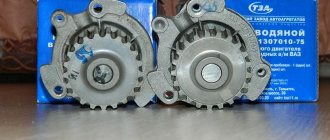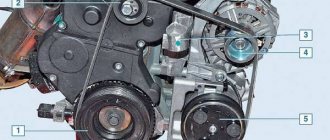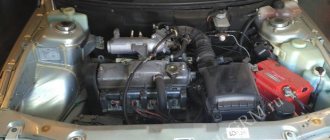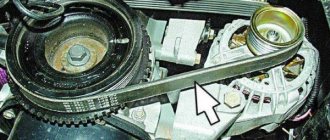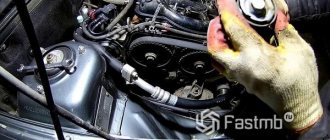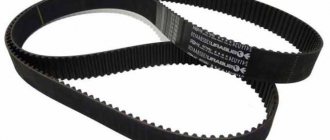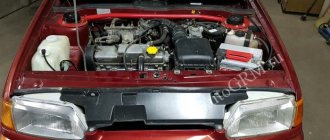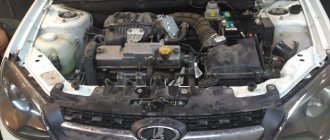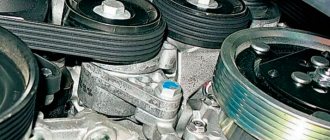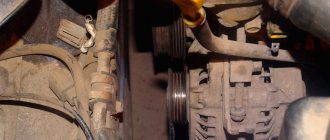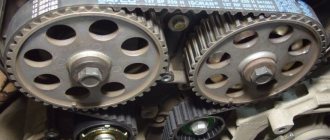If there is a squeaking sound from under the hood during rain or simply when there is high humidity, the problem is most likely in the tension of the alternator belt. The problem can be easily solved. The belt needs to be tightened. In this article we will see how to do it yourself.
You don't need a lot of tools, you just need a ratchet and a couple of 10" and 13" sockets.
This instruction is suitable not only for the VAZ 2110 model, but also for the VAZ 2111, VAZ 2112, since the principle and design of the alternator belt tensioner are similar.
- First of all, we are looking for a generator on the hood. It is located on the left under the hood when viewed from the front. I think this shouldn't be a problem.
- Now you need to loosen the top nut securing the generator.
- Now tighten the belt with the adjusting bolt.
To tighten the belt, turn the adjusting bolt clockwise; to loosen it, turn the bolt counterclockwise.
Turn the adjusting bolt a couple of turns. Now you can check if you have stretched enough. Tighten the generator mounting nut. Turn on the car and turn on the devices to maximum: heater, lights, heated rear window. If not everyone gets a whistling sound, then you did everything correctly and the belt is properly tightened.
However, if squeaking occurs, turn the adjusting bolt a few more turns. Just be careful not to overtighten the belt, this is also not very good. When the belt is tensioned, a humming noise may occur. Where does it come from? It is very easy for the generator bearing to hum due to the high pressure applied. If this happens to you, turn the adjustment screw again to slightly reduce the belt tension. The high must disappear.
The alternator belt, like any other part of the car, wears out over time. In this situation, there are some timing tips. It is necessary to replace the VAZ 2110 alternator belt strictly on time when it wears out. The VAZ 2110 8 valve or 16 valve alternator belt is easy to replace with your own hands. This is the topic of this article.
Replacing the tension roller VAZ 2110 8 valves
When is it necessary to replace the camshaft drive belt, how to remove it, as well as removing and replacing the tension roller on a VAZ 2110. When is it necessary to replace the camshaft drive belt?
This procedure must be carried out without fail if you find: Clear signs of wear on the inner surface of the drive belt: tears of fabric or rubber, or their separation from each other, cracks and other fold defects. The outer side of the camshaft drive belt also succumbed to operational defects in the form of cracks or bulges inward or outward. Oil stains or other undesirable weather defects have appeared on the belt (vehicle operation in harsh weather conditions). The end (side) part of the belt has obvious visual defects: cuts, separation of rubber from the fabric, etc.
Self-replacement of the VAZ 2110 timing belt - theory
Under the camshaft pulleys there are two rollers: support “9” (on the right side) and tension “4” (on the left). There is a special hole in the support roller, thanks to which it is attached; the naked eye can see that the hole is not located in the center, but with some offset. This feature is needed to adjust the timing belt tension by turning the roller on the axis of the mounting bolt.
The camshaft pulleys differ from each other: a synchronizing disk “8” is attached to the pulley “7” of the intake camshaft, which ensures the operation of the phase sensor; the drive is covered with a plastic cover at the front and rear.
To set the valve timing, the manufacturer provides special marks marked in the figure with the letters “A”, “D”, “E”; they can be seen on:
- On the oil pump cover;
- Pulleys (B);
- On the rear cover of the drive belt there are marks “C” and “F”.
The correctness of the phase adjustment is checked by the coincidence of mark “A” with mark “B”, and, accordingly, “D” with “E”, “C” with mark “F”.
Set the timing marks correctly - otherwise you will bend the valves!
The VAZ-21124 engine has a special feature: no matter how its pulleys are turned, it does not bend its valves. With the 21120 engine (16v 1.5 l) such jokes will not work! If the pulley positions are not too far off, try putting on the belt and turning the mechanism to the “TDC 1 and 4” position. From now on, always use the following instructions:
- The crankshaft is set to the required position by checking the mark on the generator drive pulley (photo 1) or on the crankshaft pulley (photo 2);
Alternator drive pulley and crankshaft pulley
- Let us clarify: there should be 20 teeth between the DPKV sensor and the “pass”;
- The marks on the “upper” pulleys should point straight up (photos 3 and 4). These pulleys must be fixed, after which the tension can be released;
Exhaust and intake shaft pulley
When the belt is loose, the crankshaft cannot be rotated.
In theory, on the VAZ-2112, marking is carried out the same way, no matter what engine we are talking about. Here are photos for engine 21120.
What it looks like in reality and in the instructions
Take the time to find the inspection window on the gearbox housing. There is another mark under the plug.
The last step is optional. And they do it so as not to redo all the work “from scratch.”
The number of belt teeth between the “upper pulley” marks is exactly 16; The mark on the crankshaft pulley sometimes breaks off - use the control method “1” (photo 1) or “3” (lower photo).
Updates for VAZ-21124
On a 1.6 engine, all actions are performed in the same way as described above. There is one exception - the generator drive pulley is aligned according to the mark on the casing (see photo).
Generator drive pulley, motor 21124
However, if this mark is not there, use the proven method: 20 teeth are counted from the DPKV body. Instead of the 21st there should be a “pass”.
The timing pulleys can be rotated as you like - the pistons will not touch the valves in any case. Compare what the pistons of two different engines look like and it will become clear what we are talking about.
Two different 16 valves
For those who don't understand anything
The number of teeth on the crankshaft pulley is 21, on the camshaft pulleys – 42. When the crankshaft rotates 360 degrees, the camshafts rotate 180. In general, the full engine operating cycle consists of two crankshaft revolutions (720 degrees).
In theory, you can use an alternative configuration method. Let the camshaft pulley marks point straight down. Then the mark on the crankshaft pulley should face up (TDC 1 and 4).
How do you know that the VAZ 2110 timing belt needs to be replaced?
In order to detect the need to replace the timing belt in time, it is necessary to regularly monitor the condition of the engine and pay attention to certain points. Replacing the timing belt is necessary if:
- Oil leaks are visible on the belt;
- There are numerous cracks or signs of increased wear on the surface;
- Damage to timing belt teeth;
- Belt delamination or cuts, bulges or folds;
- The appearance of threads on the surface.
More information in this video: TOP 6 signs of timing belt wear!
Why replacement is needed and signs of malfunction
Before you know what you need to do to change your belt, you need to determine when you need to do it. The following signs may indicate this:
- the appearance of whistles when starting the engine or after increasing speed;
- decrease in generator performance (clear from the sensor signal);
- partial rupture.
The whistle occurs after a simple device is triggered: a belt on the crankshaft (or rather, on the pulleys) transmits rotation to the generator. Pulleys and belts may have different designs, but the principle of their operation is the same. If parts rub against each other, squeaking or squeaking may occur. There are several reasons:
- wear of the belt when it is impossible to tension it further;
- the part is made of low-quality material;
- contact with the surface of technical liquids, gasoline.
What to do in this situation? There is no need to replace the device with a new one. Before this, it is necessary to check and determine the cause of the whistle or squeak. Please note the following:
- if the belt is damaged, it must be replaced;
- check the degree of tension;
- the belt must be dry and clean;
- the line on which the pulleys are located has not moved.
In some cases, transmission of rotation is not possible due to the rigidity of the belt. This usually happens in cold weather; after the engine warms up, the squeak disappears. If the design has a tension roller, the whistle may be due to its wear. Replacing the part completely solves the problem.
Note. If the cause cannot be determined, the belt must be replaced with a part from another manufacturer.
The belt often breaks. It is important to understand the reasons why such a situation may happen again. The cause of the rupture may be the following factors:
- natural wear and tear (the operation was carried out within the agreed period);
- the part was initially defective;
- malfunction of pulleys, shafts, tensioners;
- Belt tension is too strong or too weak.
How to Install a Timing Belt - Step by Step Guide
Everything is done in reverse disassembly sequence.
1. It is almost impossible to install the generator drive pulley incorrectly; it has a special recess, if it does not match, it simply will not fit into place.
2. When installing the belt, carefully monitor the tension of the drive branch.
3. After the belt is installed, tension it using the special wrench prepared earlier with two protrusions at the ends.
5. Having installed the key in the holes on the outside of the tension roller, turn it counterclockwise until the cutout on the outer disk aligns with the rectangular protrusion on the inner sleeve of the tension roller.
6. Using a wrench set to “15”, tighten the tension roller mounting bolt.
7. If, after installing the timing belt, belt noise is heard while the engine is running, then the tension roller bearing may be faulty or gradually failing.
8. To check this, dismantle the rollers, then slowly, rotating them, check for any play or jamming.
9. If you find that the tension roller has abnormalities in operation (play, jamming, creaking during rotation, traces of oil on the surface, replace the tension roller.
Types of alternator belts
As for the types of belts, they are as follows:
- wedge;
- polyclinic;
- serrated
The cutting of a V-belt is a V-belt. Such a part is capable of transmitting large forces and withstands significant loads. It transmits rotation from the crankshaft to no more than two devices because it cannot bend in the opposite direction. V-belts are much wider, as are rubber belts that are slightly glued together. They have longitudinal grooves on the inside. The inner surface of the timing belt has transverse grooves that help transmit rotation more accurately.
Note. In modern engines, a belt can perform the functions of many components: a generator, a compressor, a hydraulic booster, a pump, and so on; their connection can be quite complex. Therefore, it is recommended to have a diagram on hand that will make replacement easier.
In addition, replacing the VAZ 2110 alternator belt, a video of the process of which can be viewed by clicking on the link, is always carried out according to the instructions.
Replacing the tension roller is done as follows:
1. Remove the faulty roller, then install a new roller in its place and tighten using a special wrench according to the instructions described above.
2. Adjustment of the timing belt tension using a tension roller is carried out according to the instruction manual.
Replacing the VAZ 2110 timing belt has been successfully completed, start the engine and make sure that everything is in order. There is nothing complicated about how to replace a timing belt, so there is no need to pay for something that you can easily do yourself, so you can save money while gaining valuable experience.
Source
Car alternator belt device
The simplicity of the design lies in the fact that with the help of this part, rotation is transmitted from one shaft to another. Each type of engine has its own design features, so belts are made differently. Their differences are assessed according to the following parameters:
- length;
- length;
- thickness;
- profile.
Note. The part is subject to heavy loads, so it must be strong, elastic and provide good interaction with the pulleys and rollers. The main material for manufacturing is rubber, which has a fabric base on the inside. The shape of the inner surface can be changed to maintain high friction.
